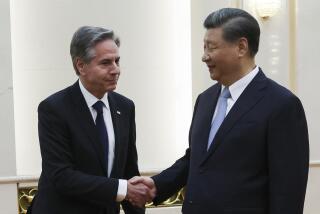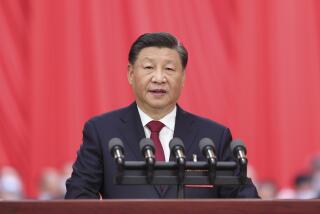Slow Going Forward, No Going Back : CHINA’S SECOND REVOLUTION Reform After Mao <i> by Harry Harding (The Brookings Institution: $32.95, cloth; $12.95, paper; 359 pp.) </i>
One hears a litany of complaints in Beijing in the wake of China’s recent 13th Party Congress. Spiraling prices and rationing of pork and sugar are reminders of times past. Not only do corruption and nepotism seem once again endemic, but virtually nothing can be accomplished without bribes. The return of prostitution and venereal disease, like the rising incidence of snail fever now that swamplands are managed by private households, similarly evoke buried memories of the Guomindang era, before the Communist Party’s successive campaigns to impose moral rectitude and mass collectivization.
One also hears nostalgic evocations of the early 1950s, when revolutionary ideals were still untarnished and “serving the people” was more than an empty slogan. But even those who decry the rampant materialism, the erosion of the Party’s authority, the perils of unleashing market forces upon a planned economy, would not choose to turn back the clock. The post-Mao reforms, what seasoned China watcher and senior Brookings Institution scholar Harry Harding considers China’s second revolution, have brought greater prosperity, or at least the prospect of change, to most of the country’s vast population.
To view Chairman Mao’s mausoleum through the windows of the world’s largest Kentucky Fried Chicken franchise is to corroborate instantly professor Harding’s opening assertion. China today, awash in T-shirts, billboards and consumerism, is indeed “almost unrecognizable to those who last visited the country before the death of Mao Zedong in 1976.” Clearly this second revolution has all but erased the vision of the new Socialist future conceived when a youthful, vigorous Communist Party wrested power with wide popular support from the corrupt and ailing Guomindang regime.
In “China’s Second Revolution: Reform After Mao,” Harding provides the first comprehensive analysis of the demise of revolutionary ideology and the accompanying political and economic advances of the post-Mao decade. Harding’s thorough and insightful examination of China’s reconstruction necessarily begins with an analysis of Mao’s legacy, then scrutinizes the ongoing strategies of current leader Deng Xiaoping.
From his carefully planned seizure of power to his sustained pressure for far-reaching economic and political reforms to his adroit removal of elderly and unenlightened functionaries from the army and from every level of civilian government, Deng has presided over China’s modernization. To the dismay of contending factions, he has repeatedly “sought the middle ground,” skillfully balancing the convictions and personal interests of those Harding calls the moderate reformers against the demands of the radicals, who press for more rapid and more fundamental change.
Deng’s balancing act has been far from easy, and, despite early successes, the future of the reforms is not yet secure. The much heralded goal of building “socialism with Chinese characteristics,” for example, has in recent months been replaced by the equally ambiguous and all-justifying assertion that China remains lodged in the “primary stage of socialism.” But no such rhetorical maneuvering can conceal the glaring contradictions between what Harding refers to as the socialist ethic and the reformist spirit.
Disagreements between the two coalitions continue to produce a “wavelike” effect, a cyclical pattern of reform whose undulations are nearly as difficult to predict at home as they are abroad. “In some years, such as 1986, the fluctuations have been intense, with China lurching from retrenchment to advancement to renewed retrenchment in a single, 12-month period.”
Although the “reforms have not been able to achieve all that their sponsors had intended,” Harding contends, “they have scored dramatic early successes . . . that enabled the reformers to build sizable reserves of grain, foreign exchange, and popular support.” Whether present policies can successfully confront the serious difficulties that have arisen in the last two or three years, like inflation, corruption, moral laxity and political dissidence, however, remains the crucial question. Unfortunately, many of the most effective devices for coping with the increasingly obvious shortcomings of reform, Harding comments astutely, “may be nearly as painful as the problems they are intended to overcome.”
Moreover, no one can foresee with confidence what will happen when the aged Deng Xiaoping, whom Harding sees as having personally engineered many of the recent achievements, passes from the political stage. In fact, “despite the sometimes dramatic cycles in reform since 1978, the most difficult stage in the course of China’s second revolution may still lie ahead.” The future of the reforms will depend upon factors as diverse as meteorological conditions and the vagaries of international markets, as well as on the permutations of Chinese politics.
Nevertheless, a measurable increase in both rural and urban incomes, dramatic gains in foreign economic relations and noteworthy achievements in political liberalization since 1978 have given the reforms wide popularity. The present momentum, Harding argues convincingly, is likely to continue, even if periods of retrenchment and retrogression intervene, as they have in Eastern Europe. Thus it is in America’s best interests, he urges, to support the process of reforms regardless of inevitably arising tensions between the two countries.
The choices ahead for China’s leaders will be far from easy. Indeed, economic changes that face strong resistance, like the implementation of price and wage reforms, of competition among enterprises, of bankruptcy procedures, have repeatedly been postponed. But, while pessimists warn that socialism and capitalism in China are on a collision course, others remain optimistic. Concern about emerging social and economic problems does not diminish an intense pride in China’s recent accomplishments or a deep sense of relief at the opportunity finally to form independent judgments and voice unsolicited complaints. Though serious problems remain, people remark repeatedly, no one could have imagined in 1978 that China would come so far in 10 years.
More to Read
Sign up for Essential California
The most important California stories and recommendations in your inbox every morning.
You may occasionally receive promotional content from the Los Angeles Times.










